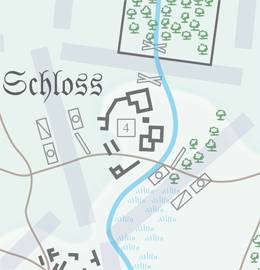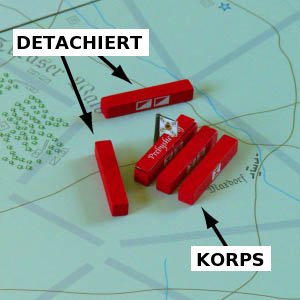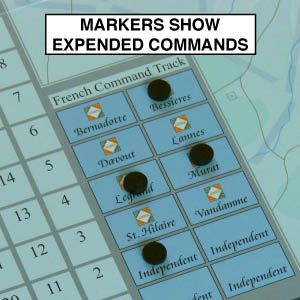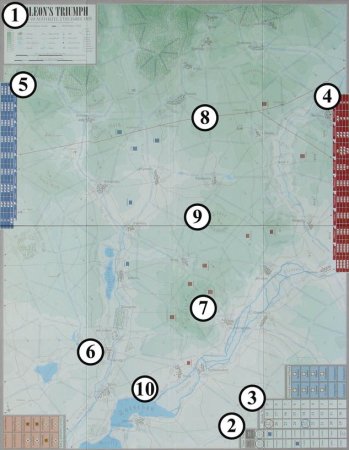 |
Legend.
The legend shows the terrain key for the game board (villages, elevation of terrain, roads, etc.). The ground scale is about 1:15000. |
|
 |
Time track. The game is played as a series of rounds, each representing one hour of time in the actual battle. Time is marked by putting a marker on the Time Track and advancing it one square each round. |
|
 |
Morale track. Both armies have a numeric morale level in the game, which is recorded by markers on this track. Each time an army loses an attack, the morale level is reduced by one for each loss it suffers. An army wins the battle by reducing the morale of the enemy army to zero, demoralizing it. |
|
 |
The Allied Army. The Austro-Russian army was over 70,000 strong. It was under the personal command of Czar Alexander who was confident of defeating the French army. He planned to attack at dawn on the morning of 2 December. |
|
 |
The French Army. While the Allied army confidently advanced, the French army laid in wait, feigning weakness. With his army's full strength hidden, Napoleon tried to lure the Allies into an attack on his deliberately weakened right, at which point he planned a devestating counter-attack with his center and left. |
|
 |
Sokolnitz. After some initial success, the Allies received their first nasty surprise when Napoleon revealed the first part of his trap: Davout's corps, which reached the battlefield just in time to bring the Allied attack to a dead stop at the small village of Sokolnitz. |
|
 |
Pratzeberg. Then the main French counter-attack began. The French center rapidly seized the Pratzen Heights. At a stroke, the French army was astride the communications between the Allied left and the rest of the Allied army, leaving the Allied army cut in two. |
|
 |
Brünn-Olmütz Highway. At the same, there was a wild fight of both armies' cavalry reserves on the French left. Charge and counter-charge. Finally the
Allies were forced to retreat in some confusion. |
|
 |
Stare Vinohradi.
Unaware of events on the rest of the battlefield, the Russian Imperial Guard advanced according to Alexander's plan – only to discover the Allied corps to their left and right in full retreat. The Guard commander resolved to retreat, but first counter-attacked to buy time. This counter-attack was stopped by a charge of the French Guard cavalry.
|
|
 |
Satschan Pond. Last, the French wheeled southwards and attacked the Allied left from behind. Thousands of Allied soldiers surrendered or were killed, and some fell through the ice of the frozen Satschan Pond trying to flee across it. As freezing rain began to fall and the early winter darkness set in, the battle of Austerlitz was over. |



 These symbols are attack penalties for infantry, cavalry, and artillery respectively.
These symbols are attack penalties for infantry, cavalry, and artillery respectively. 
 These symbols indicate obstructed or impassable terrain.
These symbols indicate obstructed or impassable terrain. 







